Dedicated to the 80th anniversary of the birth of A. A. Serebrov
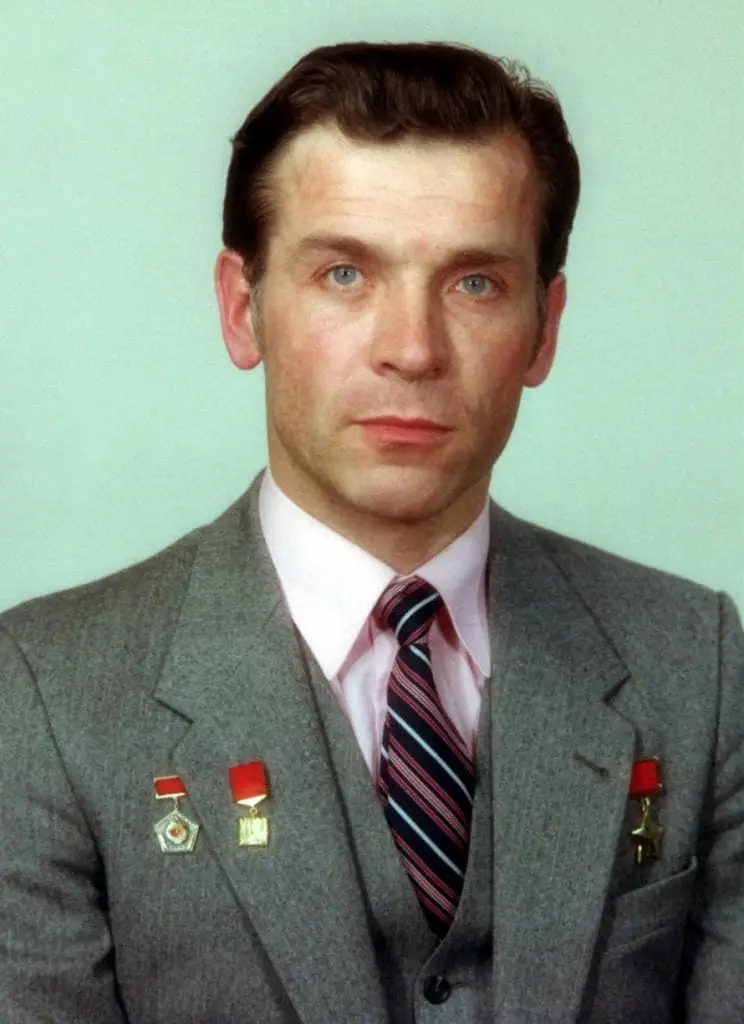
Alexander Alexandrovich Serebrov
Observing the cosmic limits as the closest reality, and the native planet as a distant oasis of life - from a distance inaccessible to its inhabitants - is what Alexander Serebrov, who conquered outer space four times, worked on the Mir station and participated in its scientific research, strived for and achieved. and practical development.
The bright life of pilot-cosmonaut and physicist engineer Alexander Aleksandrovich Serebrov, his desire to make possible something that no other earthling had ever done, is an example for all generations. In 2024, Alexander Serebrov would have turned 80 years old, so one cannot help but recall his many merits that affected stories modern Russia.
Detstvo
Alexander Alexandrovich Serebrov was born on February 15, 1944 in Moscow. The future cosmonaut spent his childhood in the Moscow region, in the village of Solnechny, where there was a sanatorium where, after military service, Alexander Serebrov’s mother, Maria Vladislavovna, worked as a doctor.
Soon it was time to go to school, and the nearest one was 6 and a half kilometers through the forest. An aunt, whose husband worked at the Kirov Tire Plant, came to the rescue. She invited her nephew to her place so that he could study at school until his mother moved somewhere closer to the city.
Alexander Serebrov spent the first seven years of his school life in Kirov; in the eighth grade he moved to Moscow. Alexander devoted all his free time from school and homework to sports. As he himself noted: “Sport helped me survive.” Being a child of post-war difficulties and having health problems in childhood - in the first 3 years of his life, Alexander suffered from pneumonia 5 times, it was sport that turned him into a strong, physically strong person, ready to conquer the highest peaks of a person.
During his school years, Alexander was involved in figure skating, basketball, wrestling, skiing, and swimming. At the age of sixteen, Alexander swam a total of 100 kilometers every month. Sports activities tempered and strengthened Alexander, restored his health, and the young man’s physical fitness was at the highest level.
It is worth noting that Alexander Serebrov studied well, he was one of the best students in physics, attended additional lectures in mathematics and physics, took part in olympiads, and studied independently using advanced textbooks. As a result, Alexander graduated from school with a silver medal, having only two B grades in his certificate - in geography and history.
As a child, Alexander Serebrov dreamed of becoming a tanker, a fireman, and a pilot, but one evening, as Alexander Serebrov himself later said: “... something changed in me.” Returning home from figure skating training in November 1957, at the prompting of coach Nikolai Aleksandrovich Brezhnev, Alexander saw a bright star moving very quickly across the sky - it was the first artificial satellite of the Earth. From that moment on, every evening after training, when the lights were turned off, Alexander looked at the sky, wanting to see a “moving star.”
On November 3, 1957, the second artificial Earth satellite was launched. After some time, he also began to appear in the sky before the eyes of young Alexander Serebrov. It is often said that childhood experiences and discoveries can become the beginning of a new, extraordinary life for a person. This is exactly what happened to Alexander Serebrov - a vivid childhood impression played a significant role in self-determination.
It was at that time, even before Yu. Gagarin’s flight into space, that Alexander Serebrov decided to become a test engineer of an ultra-modern aviation technology. In the 50s, supersonic aviation developed rapidly, and Alexander saw his future in the creation and testing of equipment that would allow flying outside the atmosphere at hypersonic speed.
From a friend of his cousin, Alexander learned that the Moscow Institute of Physics and Technology has an aeromechanical department. In the 4th year, students had to perform an independent airplane flight as course work. Inspired by this information, Alexander Serebrov, 3 years before graduating from school and the first manned space flight, decided to enter a technical institute.
After graduating from school and successfully passing the entrance examination the first time, Alexander Serebrov in 1961 entered the most difficult technical university in the world - MIPT.
MIPT
At the institute, Alexander Serebrov led an active student life, was a Komsomol organizer, a member of the DND and a physical organizer of the group, in his senior years he was a member of the faculty bureau of the All-Russian Leninist Communist Youth Union (VLKSM) and studied at the military department of MIPT. In addition, Alexander did not forget to keep himself in excellent physical shape - he was a swimmer in the faculty and institute teams.
Every summer from 1964 to 1966, he worked in the Orlyonok camp with children aged 14–18, whom he prepared for independence, taught them to understand nature and the world around them: not to get lost in the forest, to be able to navigate the terrain day and night. Astronomy was taught only in the senior 10th or 11th grades, so for most “eaglets,” educators turned out to be the first guides to astronomy. He was thanked for his good work. Coaching in children's health camps became Alexander Serebrov's starting point in educational activities, to which he devoted a considerable part of his life.
In 1983, Alexander Serebrov, in an interview with a correspondent of the newspaper “For Science,” recalled his years of study at MIPT:
After Yu. Gagarin's flight, Alexander's range of interests narrowed significantly, and after the flight in 1964 of a crew of three: a commander - a military pilot, a flight engineer and a doctor - civilians - he finally decided that his place was not in an airplane, but in a spaceship in as a flight engineer.
It is worth noting that the 1964 flight was Vostok 1, which for the first time in history was launched with three participants. In order to minimize weight, the crew flew without spacesuits and, in addition, for the first time in the world, medical examinations and tests were carried out by an astronaut doctor.
In 1967, Alexander Serebrov, having defended his diploma with an excellent mark, graduated from the Moscow Institute of Physics and Technology with a degree in Aerodynamics - Thermodynamics on the basis of the Research Institute of Thermal Processes, where all the founders and creators of domestic cosmonautics worked since 1933.
In the same 1967, Alexander entered graduate school at MIPT. He was assigned to the department of physical mechanics, took an active part in creating a workshop on aerophysics and at the same time continued to work on his dissertation. In 1970, he completed his graduate studies at the Moscow Institute of Physics and Technology with a degree in Physics of Liquids, Gases and Plasmas, and in 1974 received a Candidate of Technical Sciences degree, defending his dissertation on the topic “Problems of thermal protection of a manned spacecraft entering the Earth’s atmosphere after a flyby of Mars.”
This is how Timofey Vladimirovich Kondranin, a close friend and classmate of Alexander Serebrov, talks about his comrade:
The future cosmonaut led a correct lifestyle. He was always neat and smart. At the institute, Alexander collected all kinds of reproductions of cars and subscribed to technical magazines. He knew how to see the ordinary in the unusual and the unusual in the ordinary.
He came up with a new way to drink from a glass bottle in zero gravity, using capillarity phenomena and minimizing fluid loss.
But April 12, 1961 did not seem unusual to him. He felt that this was not fantasy at all, this was a natural stage.”
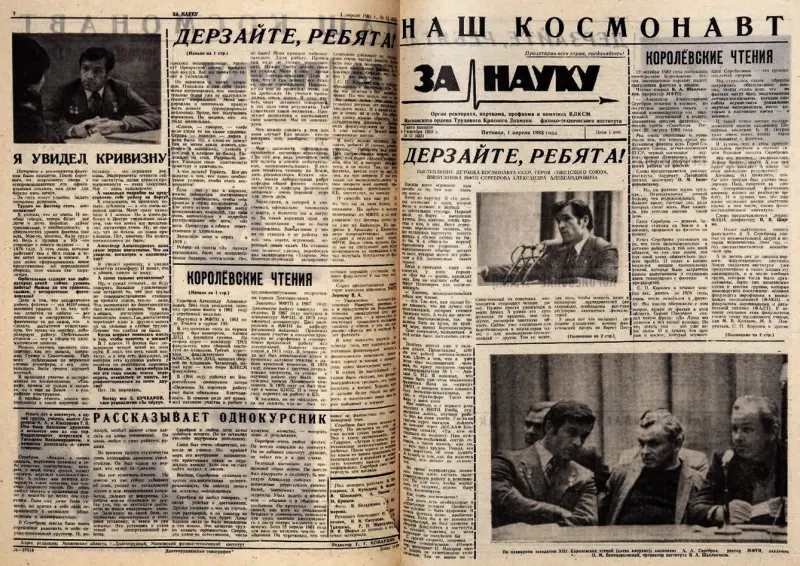
Turnover from the newspaper “For Science” in 1983, dedicated to Alexander Serebrov
Flight Engineer
After graduating from graduate school, Alexander Serebrov met with the head of the department, Professor K. D. Bushuev (technical director of the Soyuz-Apollo program), who promised to help him in his quest to become a spacecraft flight engineer.
Having undergone a medical examination to obtain permission to train, Alexander Serebrov was declared temporarily unfit. And only after 4 operations: removal of tonsils, surgery on 2 sinuses and strengthening plastic surgery on the abdominal wall, in 1975 Alexander was declared fit for special training under the cosmonaut training program.
At that time, the opportunity to become a spacecraft flight engineer was available only to employees of the Energia Research and Production Association, where the Soyuz spacecraft, Salyut and Mir stations were created. Therefore, in 1976, Alexander Serebrov had to move from MIPT to NPO Energia, to the department where instructions for operating scientific equipment on board orbital stations were developed for astronauts.
According to the memoirs of Alexander Serebrov, described in the book of the Japanese philosopher Daisaku Ikeda “Cosmos. Earth. Human. Dialogues”, moving to another job, to a new team was a difficult process. He had to work very hard, carry out any assignments, despite the fact that in the cosmonaut training group he was the only one who had an academic degree and the highest position - senior researcher.
Alexander simultaneously worked at the Mission Control Center, prepared the Salyut-7 station for flight, assembled the base unit on a wooden model of the Mir station, and wrote instructions to flying cosmonauts on scientific research in their work.
Since childhood, having learned to overcome all obstacles and difficulties, Alexander Serebrov successfully passed the exams for admission to the cosmonaut corps, and on December 1, 1978, by decision of the Main Interdepartmental Commission, he was recommended for enrollment in the cosmonaut corps of the Energia Research and Production Association as part of the 5th intake.
In dialogues with Daisaku Ikeda, Alexander Serebrov admitted his experiences before the first flight:
Alexander Aleksandrovich Serebrov made his first flight into space from August 19 to August 27, 1982 as a flight engineer of the Soyuz T-7 spacecraft (from the moment of launch to docking) and Soyuz T-5 (from the moment of undocking to landing) and the second expedition to visit the long-term orbital station "Salyut-7" together with the ship's commander Leonid Ivanovich Popov and cosmonaut-researcher Svetlana Evgenievna Savitskaya, and worked at the station with the crew of the first main expedition - cosmonauts Anatoly Nikolaevich Berezov and Valentin Vitalievich Lebedev.
Alexander Serebrov’s most vivid memory is associated precisely with the first flight, the first entry of a spacecraft into orbit:
As soon as the 526th second comes from the moment the rocket leaves the launch tube, there is a strong blow-explosion in the back, weightlessness sets in, and it seems to you that you have been tipped upside down...
Immediately the first glance is at the Earth. When separated from the rocket, the ship spins around an arbitrary axis at a speed of 0,5 degrees/min, so the panorama visible from the window, slowly floating before the eyes, is majestic, the Pacific Ocean, clouds, a horizon of an amazing range of colors, mostly blue.”
A large number of scientific experiments were carried out at the long-term orbital station Salyut-7. One of them was growing Arabidobsis grass according to the methods of Soviet biologists.
The seeds grown in space between the first and second expeditions visiting the Salyut-7 orbital station were lowered to Earth by the crew of Alexander Serebrov. Then these seeds traveled the route several more times - growth and maturation in zero gravity, descent to Earth, research - and again into space. At the same time, earthly plants were grown from “space” seeds. These studies have shown that when stored under conditions of long-term space flight, grains age 5–6 times faster than under terrestrial conditions.
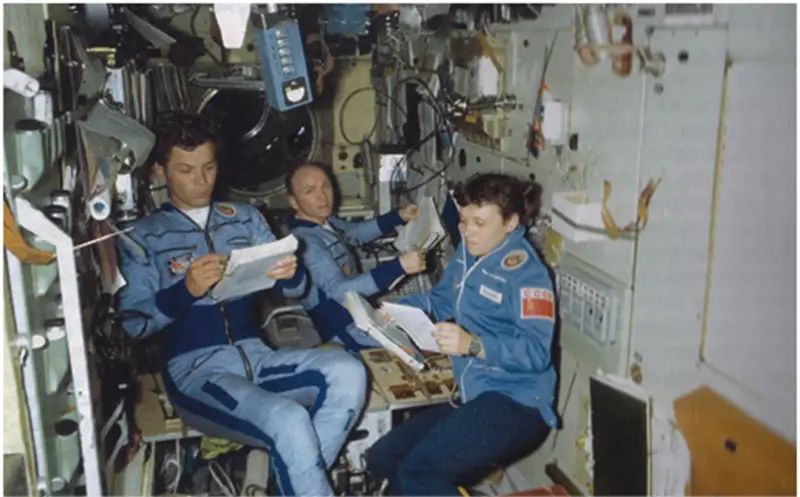
Cosmonauts Alexander Serebrov, Valentin Lebedev and Svetlana Savitskaya are preparing to conduct an experiment on board the long-term station "Salyut-7"
Alexander Serebrov's second flight into space took place 8 months after the first flight. From December 1982 to March 1983, Alexander was trained as a cosmonaut-researcher of the second crew under the program of the second main expedition to the long-term orbital station Salyut-7. A month before the planned launch of the second main expedition, Alexander Serebrov was included in the first crew instead of cosmonaut-researcher Irina Rudolfovna Pronina.
On April 20, 1983, the Soyuz T-8 spacecraft was launched. The flight program included the docking of the Soyuz T-8 spacecraft with the Salyut-7 orbital complex - Kosmos-1443, which had been uninhabited since December 1982 and was in automatic flight mode.
Emergency situations
During the flight, an emergency situation occurred: when the launch vehicle's nose fairing was released, the antenna of the Igla automatic rendezvous system was damaged. Thus, the crew, left without a radio communication system with the station and outside the radio communication zone with the Earth, flew in the shadows towards a bunch of two stations weighing more than 40 tons at a speed of more than 4 m/sec.
– recalls Alexander Serebrov.
After a successful maneuver, the flight control group did not give permission to repeat the manual rendezvous with the orbital complex, giving the command to prepare for descent to Earth, which was carried out without comment. The spacecraft landed on April 22, 1983. Alexander Serebrov remembered this flight for the rest of his life, calling it his new birth.
Between his second and third space flights in 1986, the Mir station was launched, designed by NPO Energia. Alexander Serebrov also took part in its development.
One of the flaws identified by Alexander Serebrov in the initial version of the base unit of the Mir station was the insufficient number of windows provided, which are intended for visual or visual-instrumental observation of the Earth. Alexander suggested protecting the windows from outside dust, and not just one window, but several.
As a result, the base unit had one porthole with a diameter of 200 mm in each cabin, one – 400 mm, transmitting ultraviolet light – in the “floor”, and 4 portholes (all protected by covers) on the conical part of the transition compartment. Also in the “floor” of the base block there were up to 4 more windows, through which the astronauts could observe the Earth using instruments at the station.
Another engineering challenge in the development of the Mir station was to ensure the organized movement of thermal and cooled air inside the spacecraft. Since, due to weightlessness, there is no natural air circulation inside the station, and the operating equipment produces heat, it is important to remove the heated air to avoid equipment failure.
Alexander Aleksandrovich Serebrov made his third flight into space from September 6, 1989 to February 19, 1990 as a flight engineer of the Soyuz TM-8 spacecraft and the fifth main expedition to the long-term orbital station Mir, together with commander Alexander Stepanovich Viktorenko.
During this flight, Alexander made his first spacewalk. He was given the important task of installing two star sensors on the Kvant module, which, with high accuracy based on the stars, could determine where and in what position relative to the stars the Mir orbital complex is located, and transmit this information to the on-board computer. Based on energy costs estimated on Earth, this was a very complex job, and the devices that needed to be installed were unique.
When going into outer space, the flight engineer is primarily responsible for everything, and the commander provides insurance. Due to high voltage and concentration on preserving the sensors, when moving them to the Kvant module, Alexander Serebrov lost a bag with mounting tools. However, the crew commander, Alexander Viktorenko, was able to attach the sensors to the board without the necessary tools, and their first spacewalk program was completed successfully.
This is how Alexander Serebrov describes what happened:
“The abyss has opened and is full of stars;
The stars have no number, the bottom of the abyss.”
It was a split second. Then work began.
I lost a bag of tools, but we, Sasha Viktorenko and I, did our job successfully.”
During the third flight, Alexander Serebrov performed four more spacewalks, spending a total of 17 hours and 36 minutes in outer space.
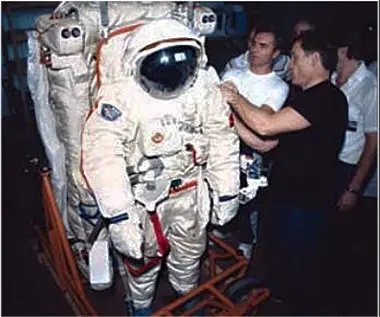
Alexander Viktorenko and Alexander Serebrov inspect the cosmonaut transportation facility (SPK)
Space motorcycle
During the fourth spacewalk on February 1, 1990, Alexander Serebrov conducted the first test of a “space motorcycle” or a means for autonomous movement of an astronaut (SPK).
In fact, a “space motorcycle” is a mini-rocket, and together with an astronaut in a spacesuit, it is an entire mini-spaceship, containing all the necessary systems, except for automatic rendezvous and orientation systems. It consists of three orientation system circuits: two semi-automatic and one manual, two jet engine circuits, 16 engines each.
Jet engines of the “motorcycle” operate on compressed air, placed in two cylinders of 300 atmospheres each. If you turn on the engines to accelerate to the side, the “motorcycle” will reach a speed of up to 35 m/sec. Telemetry about the state of the “motorcycle + astronaut” system is transmitted to the ground via an autonomous radio system.
Alexander's task was to slowly move away from the station and then turn towards it, at which time Alexander Viktorenko, the crew commander, was supposed to film him. However, something went wrong, and the “motorcyclist” was very quickly carried away 33 meters. But Serebrov managed to brake manually, and the test ended successfully for both members of the space station and the “motorcycle”.
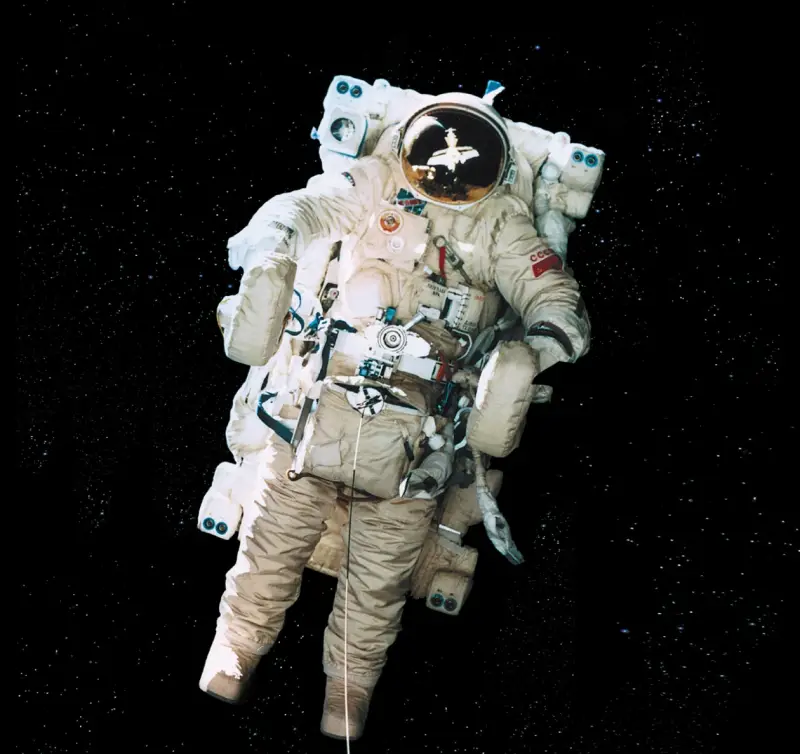
Cosmonaut Alexander Serebrov during testing of an autonomous means of moving a cosmonaut in outer space (SPK) and a new modification of the spacesuit
During his fourth and last flight into space, made between July 1, 1993 and January 14, 1994, as a flight engineer of the Soyuz TM-17 spacecraft and the Mir long-term orbital station under the program of the fourteenth main expedition, together with the commander Vasily Vasilyevich Tsibliev and cosmonaut-researcher, citizen of the French Republic Jean-Pierre Haignere, in addition to numerous scientific experiments in the field of biomedicine, astrophysics, Earth observation and materials research, two events occurred comparable in intensity to the incident during the second flight of Alexander Serebrov.
On September 16, 1993, Alexander Serebrov unhooked from the station and almost flew into endless space. This happened during the sixth spacewalk and the first in the crew with Vasily Tsibliev.
A poorly screwed handrail on one platform of the “Kvant” module, to which, according to the instructions, Alexander was supposed to be secured, unscrewed from the body. Confident that he had secured the handrail, Alexander flew to the high truss structure to secure it with another halyard. But, not having flown even half a meter, I discovered that both carbine hooks were flying side by side: one in my right hand, and the other free. For at least three seconds, Alexander Serebrov was in absolute free flight.
Fortunately, the hook came off the handrail very smoothly, did not pull it, did not turn it around, and Alexander saw the truss approaching, to which he latched onto, and calmly continued to work further.
On January 14, 1994, before returning to Earth, Vasily Tsibliev and Alexander Serebrov flew around the Mir station for a visual inspection. While in the living compartment with the task of photographing a docking station specially made for docking with the American Shuttle, a ship for delivering astronauts to the Mir station, the ship's motion control handle turned out to be disabled due to a manufacturing defect, and this could lead to a dangerous approach to module "Crystal" at a speed of about 1 m/sec.
The household compartment in which Alexander was located was very fragile and would definitely burst in a collision. But at the last moment the ship caught its antenna on the station, slowed down, and this significantly softened the blow, the compartment did not burst, and Alexander remained alive.
During his work as an astronaut, Alexander Serebrov made 4 flights. The astronaut's total flight time was 372 days and 22 hours. 10 spacewalks were completed with a total operating time in airless space of 31 hours 48 minutes. These figures were record-breaking, and were surpassed only by Anatoly Solovyov in 1997.
On May 10, 1995, Alexander Aleksandrovich Serebrov was expelled from the cosmonaut corps and dismissed from RSC Energia named after S.P. Korolev due to retirement due to length of service.
Philosophy
In addition to his main professional activity as a pilot-cosmonaut and physicist-engineer, Alexander Serebrov invested a lot of effort, energy and time in educational activities and education of young people, popularizing the endlessly interesting and mysterious world of space among schoolchildren and students. His famous “Lessons from Space” with a demonstration directly from orbit of experiments with weightlessness that he invented, numerous lectures that he gave over many years at schools and universities in the country and abroad, had an invaluable influence on the choice of life path of schoolchildren and students, many of them who linked their fate with space research.
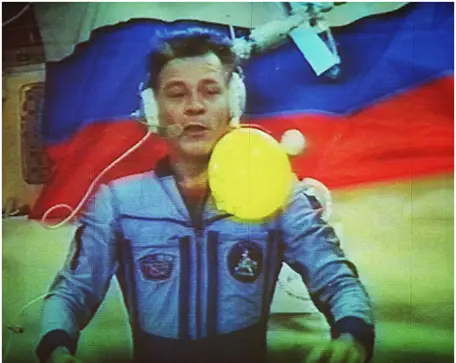
Alexander Alexandrovich Serebrov during his famous “Lessons from Space”
During two long flights, Alexander regularly, several times a week, spoke via amateur radio with schoolchildren in Australia, Latin America, Mexico, the USA, Europe, Russia and Asia. Here's how Alexander spoke about them:
Alexander Aleksandrovich Serebrov actively participated in the creation of the All-Union (since 1992 - All-Russian) youth aerospace society "Soyuz" (VAKO "Soyuz"). In August 1988, he was elected the first president of this society, which gave many students a path to rocket and space educational institutions.
Unfortunately, the stress Alexander endured during his work in space could not but affect his health. Alexander Serebrov died on November 12, 2013 at the age of 70. He was buried on November 15 at the Ostankino cemetery.
During his life, Alexander Serebrov was awarded a large number of awards: the title of Hero of the Soviet Union - for the successful implementation of his first space flight in 1982, the Order of Lenin - for the implementation of an orbital flight in 1983, the Orders of the October Revolution and Friendship of Peoples - for successful flights in orbital space. Mir station in 1990 and 1994 and many others.
The memory of Alexander Serebrov is immortalized on one of the marble stars with the names of Soviet (Russian) cosmonauts on the Alley of Cosmonauts near the VDNH metro station in Moscow, as well as in Alexander’s native secondary school No. 14 in the city of Kirov.
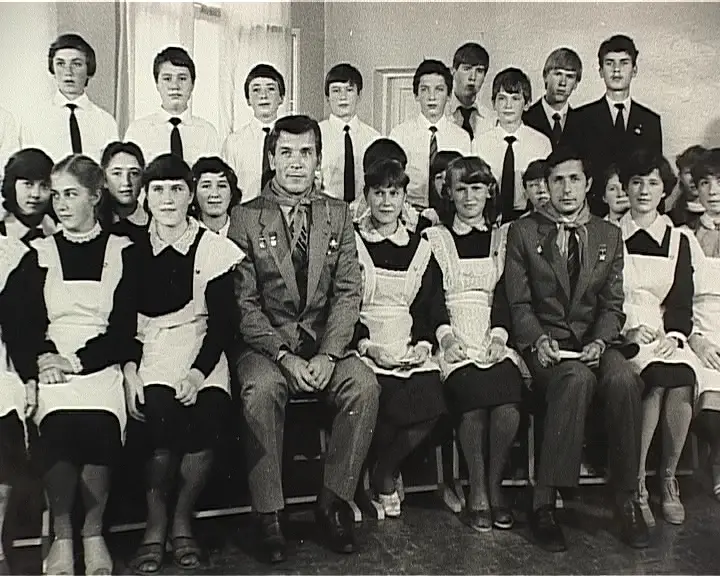
Honorary citizens of the city of Kirov, pilot-cosmonauts of the USSR Alexander Aleksandrovich Serebrov and Viktor Petrovich Savinykh visiting students of secondary school No. 14
For many years of his life, Alexander Alexandrovich tried to draw the attention of mankind to environmental problems, which he himself had to observe from space. Therefore, in conclusion, it is appropriate to quote his words addressed to Japanese students during a visit to Soka University:
It's time to master the cosmic philosophy of the common home Earth. We astronauts feel especially strongly our duty to preach this philosophy to people.”
Sources:
Alexander Serebrov, Daisaku Ikeda, “Space. Earth. Human. Dialogues". Translation from Japanese. Under the general editorship of Ekuko Saito Benz, 2nd ed., M.: Moscow University Publishing House, 2011.
Space Memorial. Alexander Alexandrovich Serebrov
Information